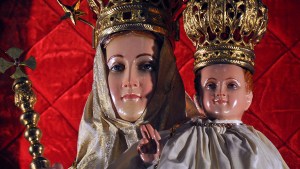Lenten Campaign 2025
This content is free of charge, as are all our articles.
Support us with a donation that is tax-deductible and enable us to continue to reach millions of readers.
In a letter sent on August 1, 2024, to Bishop Sagayaraj Thamburaj of Tanjore (India), Cardinal Victor Manuel Fernandez, prefect of the Dicastery for the Doctrine of the Faith, praises the “spiritual beauty” of the Marian shrine of Vailankanni, located in Tamil Nadu, in the southeast of the Indian peninsula.
He writes that Pope Francis has a “great esteem” for this place of faith, dedicated to “Our Lady of Good Health.”
The shrine hosts a major pilgrimage of Indian Catholics every year between August 29 and September 8.
“The same Virgin Mary who manifested herself at Lourdes also manifested herself in India as the Mother of Health,” says Cardinal Fernandez in this letter published by the Holy See on August 6.
He hails the influx of “millions of pilgrims,” particularly the sick, who visit this shrine. The shrine was recognized in 1962 under the pontificate of John XXIII. The Argentinian recalls that in 2002, Pope John Paul II decided to celebrate the World Day of the Sick there.
No syncretism
As the prefect notes, the Vailankanni shrine also welcomes “many non-Christian pilgrims.” The shrine’s image of Mary, depicted in a sari — a traditional Indian garment — with Christ in her arms, is associated by non-Christians with both the goddess Shakti, a mother figure in the Hindu pantheon honored in a nearby temple, and the fertility goddess Mariamman, particularly venerated by Hindu Tamils.
The Holy See considers that the Holy Spirit “acts” through these Hindu pilgrims who “come seeking solace comfort” and are sometimes “healed of their illnesses.”
“This should not be considered as a form of syncretism or mixing of religions,” insists Cardinal Fernandez, who asks that all visitors be made welcome.
Vailankanni’s three miracles
The origins of this devotion go back a long way, to three miracles in the 16th and 17th centuries. The Virgin of Vailankanni first appeared to a young Tamil shepherd on a hot day in May 1570. The young boy is said to have offered milk to the mother of Christ; later, he realized that his jug was still full of fresh milk.
In 1597, Mary is said to have appeared to a disabled young man who was selling curdled milk (the basis of many Indian desserts), which he offered to baby Jesus. The Virgin then asked the sick man to go to Vailankanni and build a chapel in her honor. On his way there, the man miraculously recovered, and honored Our Lady’s request.
Later, a Portuguese ship sailing from Macao in China to Ceylon in Sri Lanka was caught in a storm. The sailors invoked the Virgin Mary, and the sea suddenly calmed; saved, they contributed to the construction of the church in Vailankanni. In 2004, the church was relatively untouched by the tsunami, while the entire region was devastated by the disaster.




